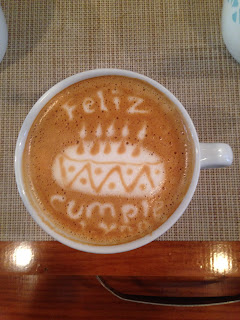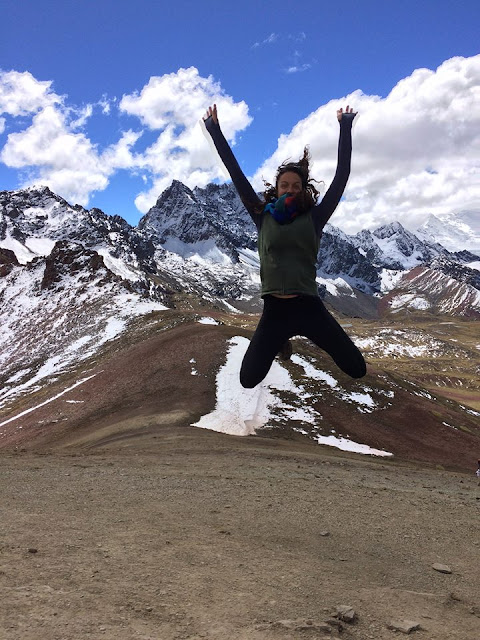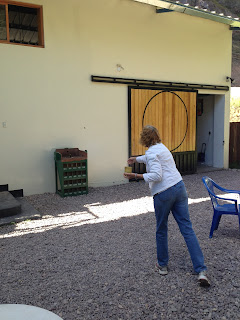My Cusco favorites
a random assortment of my favorite memories
(sorry for the lack of logic to the flow)
One of the things that people were always asking me while I was in Cusco was what I liked most about it. There are the old churches and ruins everywhere you look, the food (Peru boasts some of the best chefs and cuisine in the world), and some of the most dramatic views in the world at my doorstep, but what I would most often answer is that I loved how people in Cusco were so tied to their traditions and roots. Everywhere you look there is evidence of people who are still proud of their ancestry and take any opportunity to celebrate it. Whether bragging about how strong the Incas were to explaining the health benefits to many foods that come from Peru or are only found in Peru (thousands of types of corn and potatoes, quinoa, maca, coca, tomatoes-yes, those are New World products, not European), Cusqueñas take pride in their heritage.
I really loved this lamppost I saw in Ollantaytambo (a small village located close to Cusco) that shows the condor, the puma, and the snake, the Incan trinity. The condor represents the sky and can deliver messages to the gods. The puma represents the earth and is strong and patient. And the snake-the underworld, where it can shed it's skin and transform itself.
Did you know condor and puma are actually Quechua words we use in English? Now you do ;)
My kids (and nearly all young people) are taught and eagerly participate in traditional dances from a young age. Even some of our littlest students would learn the basic steps. As they get older they participate in the festivals, parades and school functions, decked out in the most colorful outfits. Right before some of the larger holidays, the side streets, alleys and plazas are filled with dance groups and bands rehearsing, until all hours of the night. A few times I came upon a 50+ member marching band, playing away at 11:30pm.
The two pictures above are for my send off. We often had the students do a few dances for our departing teachers or volunteers, but for my farewell, it was especially touching to think of all the hard work they put into getting the steps right.


While we're on the subject of my kids: here are a few pictures of some other fun projects we did in my last few months. Above-inflating balloons with baking soda and vinegar and below we tattooed banana skins.
As I mentioned in my previous post, running was really difficult when I first started out. I had to slowly build up my time and distance. But once I was more or less acclimatized, I ran a few races and met some other runners-locals and other foreigners. Some of them took me on some amazingly beautiful runs throughout my time there. Above, a friend of mine took us on a 20km/12mi run down the mountain to the Sacred Valley. Below/left-before the half marathon in Lima, which definitely proves that running in high altitude is great training. And below/right-my last run in the Cusco region, running among old Inca terraces. Thank you to all of my friends who showed me some new trails and pushed me beyond my limits.
Gracias a todo mis amigos quienes me mostraron nuevas rutas
y me empujaron mas alla de mis limites.
Definitely one of the best excursions I had was taking a day trip to the Q’eswachaka bridge, which is a rope bridge dating back over 600 years. Each year, the local villages gather together and rebuild the bridge. It requires that each adult from those villages make 40 arm lengths of thin rope (as seen being demonstrated by the bridge master below/right) from dried grasses. Then those thin ropes are twisted together to form thicker and thicker ropes and you eventually get this awesome structure that can withstand the weight of about 55 people.

I was lucky enough to have been invited by and accompanied by several experienced explorers, photographers and historians, not to mention a few fun ladies. Here we're attempting to braid some rope, but with all my concentration I couldn't accomplish what the bridge master could probably do in his sleep.


Any idea what I'm holding in my hands there? It's originally from the Americas, now grown a lot in Africa and consumed mostly (as in per capita) in Europe..........It's chocolate!! Or really, the cacao fruit on the left and the roasted seed on the right. Having loved chocolate forever, it was interesting to see where it originates from and how it becomes the most delicious food in the world. And I found out that you can eat the fruit (or at least the white flesh around the seeds) and the roasted seeds, which became a favorite snack of mine. I would frequent the Museo de Chocolate in downtown Cusco whenever I had guests, or not, to sample a few chocolates or liqueurs.
HATS! I loved the hats that the local women wear. Each small town has a slightly different hat that distinguished one from another. The lady on the left was just strolling across a very busy road and I loved the contrast between her old, traditional dress and the cars and buses surrounding her. The lady on the right was taking a nap in between sales of the little palm frond crosses that are popular on Palm Sunday (the Sunday before Easter).
Many people in Cusco are very religious, mainly Christians and a high percentage of those, Catholics. This was evident in the large number of shrines and chapels in the most unusual of places. Above is a small, stand-alone one, visible from my apartment, day or night thanks to the bright-green lights. I would often watch people walk by and cross themselves. Below was found situated inside a local market, next to the flowers, I'm assuming so that people don't forget to make offerings.


Setting out on a 5 day trek to Machu Picchu (one of the new 7 Wonders of the World), day 1 was highlighted by a short, steep hike from camp to see a glacier feed lake. After my sister and I arrived to find nothing but fog covering the view of the lake and the mountain behind it (above/right), we sat for a while before being told we had to start down the mountain before dark. A few minutes down the trail the fog looked like it was lifting so I decided to run back up and was rewarded with this view on the right. It actually took a few minutes to emerge and the process was magical. And it was worth the run back up and the reprimanding look from the guide for not having listened to him.
Instead of taking the more popular Incan Trail to get to Machu Picchu, my sister, brother-in-law and a few new friends took the Salkantay Trail (highly recommended), which is supposed to offer more spectacular views by taking you up to higher passes. Well just our luck, despite going in what is normally the start of the dry season, we were met with rain our first few days and when we arrived at the Salkantay Pass at 4600meters/15000feet, we could see all of about 10 feet in any one direction. Not to mention the freezing rain and wind which caused me to lose sensation in my fingers and toes for the next few hours till we descended into the jungle later that day. Oh the magic of the Andes (another Quechua word meaning "high crest").
(A little aside: Whenever I think that my Spanish or my understanding of the local culture is really starting to come together, something happens to squash that feeling. Remember chicha (the fermented corn beer that used to be made by chewing the maize)? Well, while on the Salkantay trail, I had explained to my companions all about it and so one night, after passing a local house with the chicha sign hanging out the front door, I thought it would be fun to show these newcomers a local treat (above). After inquiring from the owner/cook/brewer about her concoction we sat down to try it. The only other Spanish speaker and myself were translating back and forth as people asked about the process involved. When someone asked about how much alcohol there is usually in chicha, the woman told us that this chicha didn't have any because we were in an Evangelic community and people there didn't drink. I had to fess up to the rest of the group that any tipsiness they'd been experiencing was all in their head.
Luckily, a few days later, I was able to bring my sister and brother to a real chicharia (below)-in the backyard of some locals. Happy Easter!! )
Day 5-las ruinas de Machu Picchu!!! After getting up at about 4a.m. to get in line before 5 and then hike up the mountain (over 1/2 hour of pure steps), I was third in line to enter the park. Again, despite the disapproving looks from our guide, I was determined to be one of the first in the park in order to get a few moments alone with the grandeur that is Machu Picchu (above/left). Later in the day, after a guided tour, we climbed up Machu Picchu, which means Old Mountain in Quechua, another long, 2-hour hike up mostly stairs. At the top we were once again greeted with fog, but after some waiting, it cleared and we could glimpse the ruins below (above/right).

A coworker and myself won a raffle at pub quiz one night-a pisco cocktail making class for 2 at a local establishment (owned by a friend). Pisco is THE local spirit of Peru (although there is an ongoing debate/argument with Chile about who first invented it). Pisco is a clear, strong liquor made from distilled grapes. After the Jesuits were suppressed in Peru and left their vineyards to inexperienced landowners, the wine grapes were used primarily for pisco. The liquor actually made its way up to San Francisco during the Gold Rush, where the forty-niners liked how it was stronger than other accessible spirits.
Now pisco is popular as either a pisco sour (like a whisky sour but with pisco) or a Chilcano (pisco with ginger ale).
The best present I could have asked for-my parents arrived on my 33rd birthday! And following the advice given by experts on how to avoid getting altitude sickness, we minimized their movement the first day by going to a craft brew fest which was supporting my school. Win-win all around!
I also got spoiled by a few friends throughout the day. I had become friends with a few local guys who own and operate a coffee cart, serving the best and most beautiful coffees in the city if not all of Peru. One of the guys specializes in "latte art" as you can see above. (the butterfly wasn't for my birthday but I had to show off his skills) If you're in Cusco, go to Three Monkeys Coffee!
Below another friend who is a bartender at a nice restaurant went all out when he learned it was my birthday. First he had the kitchen prepare this dessert plate for me. And then he mustered all of his bartending skills to present me with one of the most intricate and elaborate drinks I've ever had.
 |
| Add caption |
A flaming glass upside down on a pair of knives over a martini glass. Then a flaming shot plus another shot were poured over the already flaming tower. Watch my expression change from intrigue and curiosity to.......
.......disgust and dread at having to finish the shot. After melting 4 straws I begged myself out of having to complete the drink. It was just too horrible to handle. But it's the thought that counts, right?
Another pub quiz raffle win-Rainbow Mountain or Vinicunca or Montana de 7 Colores- is a newly popularized day trek from Cusco. The looooong (3+ hours), early-morning drive and the fact that I was extremely unprepared with clothing was a poor start to the hike (a quick, steep ascent) to see the striped mountains and rolling hills pictured behind us here. The tour companies in Cusco photoshop the s#*t out of this scene normally so the colors weren't quite as brilliant as we'd seen advertised. Luckily we were very satisfied with the view on the other side (see below) of Ausangate, a 6,385m/20,945ft glacier that can be seen from Cusco (remember-a 3+ hour drive away!!!!!). And yes, I was that excited ;)
Inti Raymi (Sun Festival), is celebrated every June 24th, to celebrate and honor the sun god (Inti) on/near the shortest day of the year (remember people-this is the southern hemisphere), and to ask him to come back in order to bless the land with light. After some ceremonial events at Qoricancha (Golden Temple), a procession including the Inca and his wife parades through the streets and around the Plaza de Armas several times before ascending the mountain to Sacsayhuman (or as many guides like to jokingly pronounce, "Sexy Woman") meaning Falcon or Eagle Fortress, which overlooks the city. There, a mock offering of a white llama is offered to Pachamama (Mother Earth).
check out this link to get some better visuals of the whole festival-it's beautifully done:
I however took the easy route out and saw the procession around the plaza and then went with a friend to eat the traditional chiri-uchu (cold-spicy) dish. It's a combination of little bits of food from regions throughout Peru. There is guinea pig, chicken, jerky (another Quechua word meaning "dried flesh"), corn, cheese, torreja, seaweed, and fish eggs, topped with a slice of red pepper. There were literally hundreds of stalls filling one large plaza all serving the same dish with thousands of people coming in and out all day. Very salty, pretty delicious.

Tire art!!! From day 1 in Cusco I fell in love with the tire art available on the streets. However, it wasn't until one of my last few days there that I actually stopped to photograph these awesome creations. Above/left-a car or dune buggy, complete with plastic chairs; above/right- a frog-like planter; and below-another frog-like planter.


Another thing I saw on day 1 and also meant to stop and appreciate-this gorgeous house. I passed by La Hacienda Angostura every single day on my hour commute to work. However, not until one of my last days in Cusco did I decide that it was now or never, and I ran the 14 kilometers/9miles out there in order to snoop around a bit. The house dates back to 1639, and is one of the largest houses in the Cusco region. It has had several owners over the years and presently is owned by the local village. Many families currently live inside, but arriving so early in the morning, I didn't have the courage to knock on anyone's door to ask for a tour. I feel like I missed out on a huge opportunity to see some amazing (if not devastated) architecture inside.
I always seem to get behind the bar wherever I live. Arriving in Cusco last year I quickly became friends with the owners and the brewer at Zenith Brewery. It was my "local" for my time there and I would often hop behind the bar to serve a few beers or wash glasses if things were busy. I also helped out at a beer fest in Lima in May. I definitely want to thank the owners of Zenith and all the workers there for being my family and for making some amazingly delicious beers.
Below are other people that became my family in Cusco, although many are missing as well. Thank you all for your help and support during the year. I couldn't have done it without you.

























































